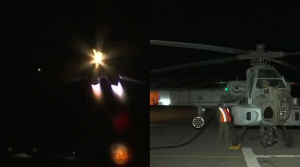 NEW DELHI: Indian Air Force’s (IAF) MiG-29 fighter aircraft and Apache attack helicopter conducted night sorties at the forward bases near India-China border to keep an eye over the Line of Actual Control (LAC) in the aftermath of the Galwan Valley clashes between Indian and the Chinese troops in eastern Ladakh last month, said reports on Tuesday.
NEW DELHI: Indian Air Force’s (IAF) MiG-29 fighter aircraft and Apache attack helicopter conducted night sorties at the forward bases near India-China border to keep an eye over the Line of Actual Control (LAC) in the aftermath of the Galwan Valley clashes between Indian and the Chinese troops in eastern Ladakh last month, said reports on Tuesday.
“Night operations have an inherent element of surprise. The IAF is fully trained and ready to undertake entire spectrum of operations in any environment with help of modern platforms and motivated personnel,” Group Captain A Rathi, senior fighter pilot at a Forward Air Base near India-China border, was quoted as saying.
The patrolling by IAF’s MiG-29 fighter aircraft and Apache attack helicopter comes amid heightened tension between the two countries post the Galwan Valley clashes in the night of June -15-16 in which at least 20 India soldiers and an unverified number of Chinese troops were killed.
The Indian Army and IAF have ramped up their operations long the LAC after the Galwan incident and the focus shifted back on LAC after Prime Minister Narendra Modi made a surprise visit to Ladakh recently.
PM Modi visited Ladakh to review the situation at the LAC and later met the injured soldiers at the General Hospital at Leh on Friday. While interacting with them, PM Modi told them that their bravery will be a “source of inspiration for times to come” and added that 130 crore Indians are proud of them.
“We will never bow down to any power of the world, said the Prime Minister in a veiled reference to China. post-Galwan Valley clashes, the Indian Air Force has raised the alert level in all its front-line bases tasked to keep an eye on the LAC, the 3,500 km de-facto border between the two nuclear-powered countries.
The IAF has also pressed into service a fleet of C-17 Globemaster III transport aircraft as well as C-130J Super Hercules in transporting heavy military equipment and weaponry to several forward bases to further ramp up India’s military preparedness in the region.
The IAF is also using its Ilyushin-76 fleet to transport troops to various areas along the Line of Actual Control, the 3,500 km de-facto border between India and China, news agency PTI quoted Defence sources as saying.
The sources said that the Air Force has already moved a sizeable number of its frontline Sukhoi 30 MKI, Jaguar, Mirage 2000 aircraft to several key airbases including Leh and Srinagar.
Meanwhile, it has also emerged that China has reportedly agreed to pull back its troops and vehicles and has moved by almost 1.5 kilometres back at three friction points — Galwan, Hot Springs and Gogra.
Army sources said that disengagement with PLA, as agreed upon at Corps Commander-level talks, has started as per agreed terms in the Corps Commander’s meeting.
According to reports, Chinese’s PLA was seen removing their tents and structures at Patrolling Point 14. Rearward movement of vehicles of the PLA was also seen at General area Galwan, Hotsprings and Gogra Post, official sources added.
However, Chinese heavy armoured vehicles are still present in the depth areas in the Galwan river area. The Indian Army is monitoring the situation with caution, Army sources informed. Senior army officials from the Indian side confirmed that a physical verification has been conducted to verify these claims.
The tension between India and China escalated manifold after 20 Indian soldiers were killed in a violent clash in Galwan Valley on June 15. The Chinese side also suffered casualties but it is yet to give out the details. India has been insisting on the restoration of status quo ante in all areas of eastern Ladakh to restore peace and tranquillity in the region.
India and China have held several rounds of diplomatic and military talks in the last few weeks to ease tension in the region. However, there was no visible sign of end to the standoff though the two sides agreed to initiate disengagement of the forces from the region.
India on Thursday said it expected China to ensure expeditious restoration of peace and tranquillity in the border areas in sync with provisions of relevant bilateral pacts.
Following the Galwan Valley clashes, the Army has sent thousands of additional troops to forward locations along the border besides moving in heavy weapons.
Leave a Reply